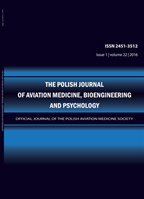2017, Volume 23, Issue 1
THE INFLUENCE OF SELECTIVE COOLING OF THE BODY SURFACE ON THE IMPROVEMENT OF PHYSIOLOGICAL INDICATORS OF THE BODY AND THE SUBJECTIVE ASSESSMENT OF THERMAL COMFORT DURING ACTIVITIES CARRIED OUT IN THE HOT CLIMATIC ZONE
Anna PRZEWODZKA1, Anna CZERWIŃSKA1
-------------------------------------------------------------------------------------------------
1Military Institute of Aviation Medicine
Autor korenspondencyjny: Anna PRZEWODZKA; Military Institute of Aviation Medicine; email: ajanusin@wiml.waw.pl
Full text
Streszczenie
Introduction: The aim of the study was to determine whether the applied type of selective cooling of limited neck area improves physiological parameters of the body and changes subjective sensations of thermal condition and fatigue level.
Methods: The experiment was attended by 12 healthy men who were not accustomed to high temperatures. Two experimental series were carried out throughout the study (the 1st series was a control group, without selective cooling, in the 2nd series a "cooling pad" was applied in the neck area). Each unit test was performed under simulated positive heat load conditions (Ta = 40 ± 1°C, RH = 30 ± 1%, t = 90 min) accumulated with moderate physical effort. The thermal exposure included three stages: 1) 10 min period of adaptation to environmental conditions, 2) 20 min period of effort on cycling ergometer performed in three repetitions (alternating with 5 min period of rest) and 3) 10 min period of rest. During the individual examination, changes in core body temperature (Tc), heart rate (HR) and body weight were recorded. At the beginning and in 90 minutes of the exposure in the thermal chamber the subjects made a subjective assessment of the state of thermal comfort felt in relation to the whole body and the degree of nuisance of the work performed.
Results: As a result of exposure to simulated heat conditions (40°C) combined with moderate physical activity, the heart rate increased significantly (p < 0.05). In the first series of experiments, the mean value of heart rate (HRmean) achieved in the thermal chamber was HRmean = 93 ± 4 bpm, whereas in the II series HRmean = 86 ± 3 bpm (statistically significant difference, p < 0.05). Average core body temperature values in both experimental series were similar (Tc = 37.0 ± 0.2°C). The dynamics of change of this parameter was almost the same in both series I and II. In control conditions, the total loss of water from the body along with sweat was on average ∆ = 0.91 ± 0.12 kg and as a result of the action of the “cooling pad” ∆ = 0.78 ± 0.23 kg (n.s.). The subjective evaluation of thermal comfort by the respondents at the end of the first series of experiments deteriorated and was assessed as "too warm" (6.1 ± 0.4). Respondents using selective cooling in the same test phase described the state of thermal comfort as "pleasantly warm" (5.2 ± 0.7). The subjective evaluation of the workload nuisance (fatigue) in the last minute of cycling ergometer operation was rated at the level of 6.1 ± 0.6 (series I) and 5.0 ± 0.4 (series II) (p < 0.05).
Conclusion: Under thermal stress conditions, the psychophysical state of the body determines, to a large extent, the feeling of thermal comfort and fatigue level. As a result of the use of "cooling pads", favourable changes in physiological parameters (heart rate, sweat loss) and improvement of subjective sensations were achieved, both in terms of thermal comfort and the degree of nuisance of the work performed.
Słowa kluczowe
selective cooling, cooling pad, psychophysical condition, thermal comfort, fatigue, workload
